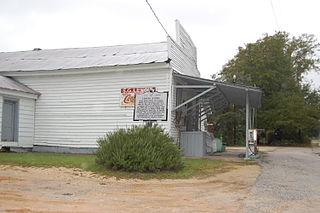
The Lenoir Store built in 1869 is an historic general store building located at 3240 Horatio Road in the High Hills of Santee community of Horatio, South Carolina. It stands on the same site where the Lenoir family has operated a general store since before 1808 and "is the oldest business establishment in Sumter County". Since 1900 it has served as the post office for Horatio Zip Code 29062. On July 3, 1997, it was added to the National Register of Historic Places. As of that date, it was still being operated by members of the Lenoir family. Lenoir is pronounced le-nore or len-wa by some of its more northern members.

Concord Presbyterian Church is a historic Presbyterian church located near Winnsboro, Fairfield County, South Carolina. It was built in 1818, and is a one-story, brick, gable-roofed building with a meeting house floor plan. It has a small, rectangular, gable-roofed rear extension and sits on a granite foundation. Also on the property is a cemetery with a cast-iron fence and gates.

Liberty Universalist Church and Feasterville Academy Historic District is a national historic district located near Winnsboro, Fairfield County, South Carolina. The property encompasses four contributing buildings constructed between 1830 and 1845. They are the Liberty Universalist Church and three buildings associated with the Academy: a boarding house, a kitchen, and a school building.
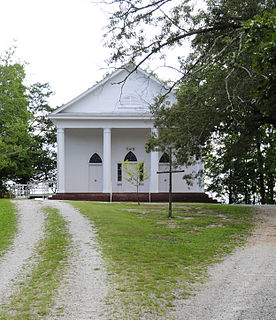
Monticello Methodist Church is a historic Methodist church off SC 215 in Monticello, Fairfield County, South Carolina. It was built in 1861, and is a one-story, front gable-roofed, weatherboarded frame building in the Greek Revival style with a meeting house floor plan. The façade features a portico is supported by octagonal wooden columns on a stepped brick entrance. Also on the property is the church cemetery.
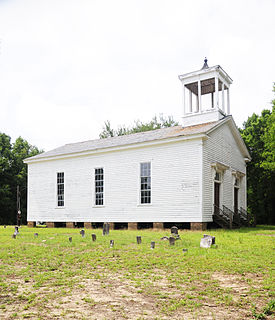
Ruff's Chapel is a historic Methodist chapel at U.S. 21 and SC 34 in Ridgeway, Fairfield County, South Carolina. It was built about 1870, and is a single-story, rectangular frame building, sheathed in weatherboard, with a front gabled roof. It has a square open belfry with a metal covered bellcast hip roof and a ball finial.

Tocaland is a historic plantation house located on S.C. Route 344 near Winnsboro, Fairfield County, South Carolina. It was built about 1854, and is a 1 1/2-story, weatherboarded frame Greek revival style dwelling on a raised basement. The front facade features four 8-foot high stuccoed granite piers that support a pedimented front porch. The porch is supported by four paneled wooden pillars, pilasters, and has a plain balustrade.

Davis Plantation is a historic plantation house located near Monticello, Fairfield County, South Carolina. It was built about 1845, and is a two-story, white frame Greek Revival style house. It has a hipped roof and two mammoth chimneys. It features a gabled front portico supported by four square, paneled Doric order columns. The house was built by James B. Davis, descendant of Revolutionary War Captain, James Kincaid, and an early pioneer in South Carolina agricultural development.

Fonti Flora Plantation is a historic plantation house located near Monticello, Fairfield County, South Carolina. It was built about 1836, and is a 2-½ story clapboard residence set on low foundations. The front façade features a full width two-story Greek Revival portico supported by six square paneled piers. Additional decorative detail includes the Gothic Revival style tripartite Gothic windows on the front and side facades.
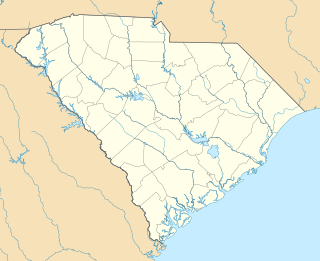
Mount Hope is a historic home located near Ridgeway, Fairfield County, South Carolina. It was built about 1836, and is a 1 1/2-story, vernacular weatherboarded building on a raised brick basement. It has a gable roof and three pedimented dormers. Also on the property are a frame smoke house and a tenant house. It was the home of Dr. John Peyre Thomas, a prominent physician and amateur scientist.
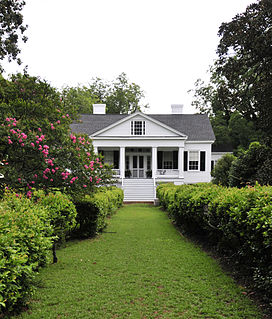
Rural Point, also known as Robertson House and Doty House, is a historic home and garden located at Winnsboro, Fairfield County, South Carolina. It was built in 1852, and is a 1 1/2-story, 12 bay, Greek Revival style frame dwelling over a high basement. The façade features a gable-roofed porch which is supported by four square columns. The property features a semi-formal garden said to have been designed by John Grimke Drayton, noted landscape architect of Magnolia Gardens in Charleston, South Carolina. Also on the property is a typical southern planter's office of white clapboard. It was built by William Ross Robertson, probate judge and commissioner of equity of Fairfield County who served in South Carolina House of Representatives and as a member of the Secession Convention.
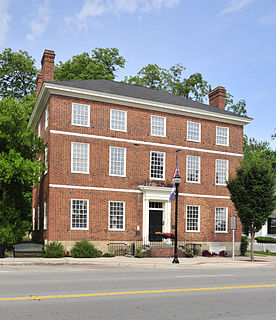
Ketchin Building, also known as the Fairfield County Historical Museum, is a historic building located at Winnsboro, Fairfield County, South Carolina. It was built about 1830, and is a three-story, five bay, Federal style brick building with a hipped roof. Originally built as a dwelling, it was sold in 1852 and was used as a school for girls until closed by the American Civil War.

Camp Welfare is a historic African-American religious campground located near Monticello, Fairfield County, South Carolina. It was founded after the American Civil War by the African Methodist Episcopal Zion Church. It is a collection of approximately 100 one-story, frame, weatherboarded cabins called tents arranged in a double "U"-shape. The focal point of the camp is the arbor; a rough, gable roofed wooden shelter with wooden benches. Also located at the camp is Zion Church; a frame building with a gable roof surmounted by a belfry built about 1930.
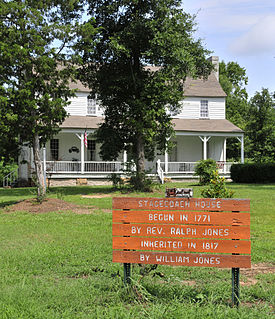
Vaughn's Stage Coach Stop is a historic stagecoach stop located near Ridgeway, Fairfield County, South Carolina. It was built about 1820, and is a two-story, weatherboarded frame, gable-roofed residence with a double-pile and central hall floor plan. The building sits on a foundation of stone piers, has end chimneys, rear shed rooms, and a left rear addition. The façade features a one-story, shed-roofed porch with a plain wooden balustrade supported by six slender wooden posts.

Dr. Walter Brice House and Office is a historic plantation house and office located near Winnsboro, Fairfield County, South Carolina. It was built about 1840, and is a two-story, weatherboarded frame, L-shaped Greek Revival style dwelling. It features a two-tiered, pedimented front verandah supported by four wooden pillars. The Dr. Walter Brice Office is a 10-foot-by-12-foot weatherboarded frame building with a metal gable roof. Dr. Walter Brice was a prominent Fairfield County planter and physician before the American Civil War.

Furman Institution Faculty Residence is a historic residential building located near Winnsboro, Fairfield County, South Carolina. It was built about 1837, and is a two-story, brick building with a hipped roof and end chimneys. It has a single story, hip roofed front porch and a kitchen extension. The building serves as a visible reminder of the early history of Furman University and its brief establishment in Fairfield County.

Ridgeway Historic District is a national historic district located at Ridgeway, Fairfield County, South Carolina. The district encompasses 31 contributing buildings in the town of Ridgeway. A majority of the buildings in the district were built between 1890 and 1915, the heyday of cotton production in the area. The district includes a commercial block with a predominance of simply ornamented two-story brick stores and a residential block with primarily asymmetrical, frame, weatherboarded houses lining the tree shaded streets. Styles include Queen Anne, Neo-Classical, Victorian, and Bungalow. Notable buildings include the J. Spann Edmunds House, Augustus Talley Moore House, Thomas Co. Store, Ruff Furniture Store, Dobson's Drug Store, Ridgeway Town Hall, Ruff's Gin Shop, James Team's Drugstore, and the Charlotte and South Carolina Railroad House.

White Oak Historic District is a national historic district located near Winnsboro, Fairfield County, South Carolina. The district encompasses 12 contributing buildings in the rural community of White Oak. The buildings in the district were built between about 1876 and about 1925, and includes three large frame residences, a frame church with steeple, two frame store buildings, a cotton warehouse, and two vacant, wooded lots, some of which reflect Victorian stylistic influences. Notable buildings include the T. G. Patrick Store, McDowell's Store, White Oak Cotton Warehouse, Matthew Patrick House, T. G. Patrick House and outbuildings, and White Oak A.R.P. Church and Manse.

U.S. Post Office is a historic post office building located at Florence, Florence County, South Carolina. It was built about 1906, and is a three-story, sandstone and brick building with hipped roof Second Renaissance Revival style. A major three-story addition to the rear of the building was built about 1935.

Fairfield Historic District is a national historic district located at Fairfield, Hyde County, North Carolina. The district encompasses 54 contributing buildings, 1 contributing site, and 1 contributing structure in the village of Fairfield. The district includes notable examples of Italianate and Carpenter Gothic style architecture dating to the last half of the 19th century. Notable buildings include the Blackwell-Carter-Midyette House (1850s), Dr. Patrick Simmons House (1871), Carter~Holton-Sears House, Fairfield Methodist Episcopal Church (1877), E. S. O'Neal And Sons Store, Calhoun Brown Store, Fairfield Cemetery Pavilion, and Carter-Swindell House (1870s).

























